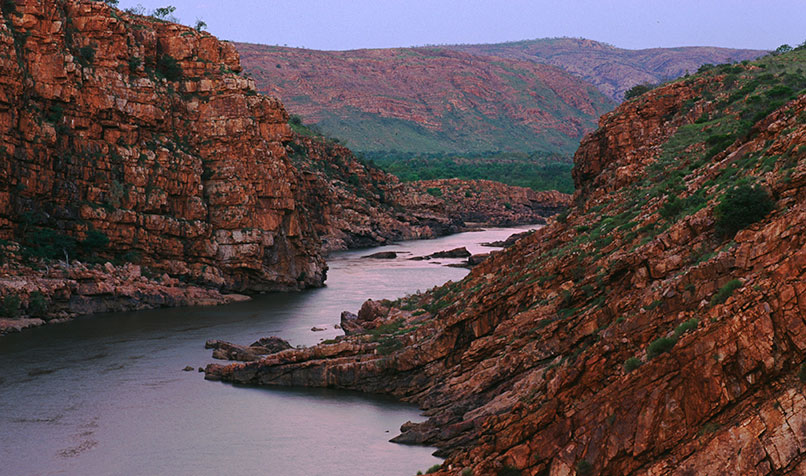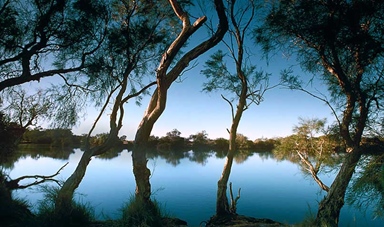Loading component...
At a glance
If there is such a thing as a no-brainer investment, it might just be water. Its slow but steady dissipation is one of the great fears associated with scientists’ climate change predictions. We all need it, it’s always in demand and it is often described as the world’s most precious resource.
Even the movies are telling us to invest in water. At the end of 2015’s The Big Short we were told that the man who shorted Wall Street, Michael Burry, was moving into H2O.
Climatologists at the Commonwealth Scientific and Industrial Research Organisation (CSIRO) have forecast that the southern part of Australia will receive 10 per cent less rainfall and run-off by 2030 than it does now, and the signs are already here. The Bureau of Meteorology recorded June 2017 as the driest ever for large parts of southern Australia, and the winter for the whole of the country was the ninth driest on record.
"People just don’t know about water. They think that if you own water, you have to own property. You don’t."
Yet as water volumes decline, demand for water is steadily rising. Australian agriculture is following the money, catering to South-East Asia’s growing taste for foods such as avocados, almonds and citrus. Many farmers are switching to these high water-usage crops from relatively low water-use agriculture, such as wool and dairy production.
Yet if water usage is increasing, food markets are growing and climate change is coming, surely the value of the underlying commodity can only move one way.
Water: A new market slowly opens
Water is finite and the Australian Government has put restrictions on how much can be traded and how much must be retained for the environment. Those regulations mean 65 per cent of the Murray-Darling Basin water is off limits to water traders, but that still leaves plenty to trade with; about A$15 billion of water rights are available to irrigators, according to the National Irrigators’ Council.
That’s a lot of money, but only a handful of institutional fund managers invest directly in water, and not a single retail fund does so. Only two easily investable shares could be described as offering direct exposure to the water markets – agricultural stock Webster, and the very recently listed fund Duxton Water.

Australia claims the world’s toughest water regulations but lately its efficacy has come under question. Recent allegations of illegal siphoning of water from rivers in northern NSW have been brushed off by some industry participants, but many others remain concerned about water regulation and compliance.
Water trading has long been considered a closed cabal, the preserve of in-the-know farmers and irrigators. That’s understandable as they’re the big users, but closed shops also tend to lack transparency.
Lex Batters, chief executive of recently launched water exchange H2OX, says that until the exchanges brought in central pricing, users “were making up their own prices”. Since the advent of real-time pricing, irrigators, farmers, water brokers and investors can now trade water up and down the Murray-Darling – it’s open to all.
The four water exchanges with national footprints in Australia are H2OX, Waterfind, Ruralco and Water Exchange. They all offer easy access for investors but the products themselves are not easily understood. Trade on any of these platforms and you’ll soon realise all water is not equal.
There are several hundred classes of investible water securities. There’s high- and low-security water, and price can vary drastically by type, demand and geography. Allocation allowances vary from river to river. You have to know what drives value and which agriculturalists are in the market.
Water investment: know your product
“You have to know what commodities that water supports, what are the drivers of climate in any particular region, what’s supply and availability in the area. Farmers will know this but the man on the street won’t have a clue,” says Kim Morison, who runs the Blue Sky Water Fund, which has been achieving annual returns of about 15 per cent since its inception in 2012.
For this reason, nobody is contemplating a retail fund for mum-and-dad investors. Yet savvy individual investors, such as David Williams, have made fortunes from water investment.
Williams, a corporate adviser and self-described “water bandit”, is a former chairman of Tasmanian aquaculture company Tassal. He was offered rights over 10,000 megalitres of water in return for a A$10 million investment in new irrigation schemes in the Tasmanian Midlands and lower South Esk schemes.
"Climate change has been part of our thinking. Water was always going to become a more precious commodity."
In the past five years, Williams says he has watched his water values rise from about A$1000 a megalitre to close to A$2000.
“People just don’t know about water,” Williams says. “They think that if you own water, you have to own property. You don’t.
“I’m now leasing my entitlements at 8 per cent yield a year, but at double the prices I paid for it. The capital gain has been 20 per cent a year.”
Williams is part of a relatively new breed in agriculture: the water baron. About 8 per cent of the Murray-Darling is reportedly owned by pure water investors, says Rich Gilmore, country director of Nature Conservancy Australia, and in his opinion that’s not a bad thing.
Nature Conservancy Australia was instrumental in setting up the Murray-Darling Basin Balanced Water Fund in 2015, along with the National Australia Bank and private investors, and Gilmore says the ability to buy water in its own right has improved price efficiency and, in turn, attracted newcomers.
Institutional investors looking on
In the past year, there have been several funds raising capital for water, including Gilmore’s, whose fund is the only one with an environmental remit to return water to depleted wetlands.
“We’re talking about a market which is much smaller than property or listed equities, but still comfortably the largest water market in the world. It’s big enough now to accommodate institutional investment,” Gilmore says.
The Murray-Darling Basin Balanced Water Fund has raised A$34 million in debt and equity and will be progressively looking to fill the A$100 million subscription in four tranches.

One of the few super funds to invest in water, VicSuper, has been accruing entitlements for close to a decade, initially investing in land in southern Victoria. Its chief executive Michael Dundon told INTHEBLACK that agriculture was the lure, but that the land came with water entitlements, which proved to be increasingly attractive over time.
VicSuper’s water is managed by Kilter Rural, which also manages the underlying assets of the Murray-Darling Basin Balanced Water Fund.
“Climate change has been part of our thinking,” says Dundon.
“Water was always going to become a more precious commodity, and we knew the federal government was buying back water. It could only appreciate,” he says.
Water – not land – has been the heavy lifter in the fund. VicSuper now has about A$150 million worth of water rights, almost three times the value of the agricultural land in its portfolio.
Gilmore believes more institutional players will arrive as the funds grow in size and show they are able to pay out regular distributions. “They can build off the lead made by the impact investors,” he says.
Water's rising values, rain or shine
For many investors, water remains an anomaly: an easy investment that’s difficult to understand. Its attraction is that values are expected to increase, even in good rainfall years.
Estimates by government agency Aither project a 10 per cent per annum increase in water prices in low rainfall years, and at least a 7 per cent rise in higher rainfall years.
This is a non-correlated asset, free from the whims of other financial markets. Williams is sanguine about it: “This is a great investment for your superannuation,” he says.
Water trading
Water exchanges offer two possible trades – permanent water entitlements (in which you are buying the rights to an asset long term), and temporary water allocations (the yield of that asset).
Prices in any one river system can vary greatly. Lex Batters at H20X water exchange says the entitlements market is less volatile: “The values of entitlements may fluctuate but you always retain the asset,” he says.
Each water entitlement has certain rights and is handed allocations by state water agencies during the year, depending on current and expected climate conditions.
High-security water (called high reliability water in Victoria) gets priority on allocations, while general security water could receive no allocations at all. If the rain stops so do the allocations, so there is a big gap in the price of high- and general security classes.
In June 2017, a single unit of Murrumbidgee high-security water (equivalent to a megalitre) was priced at about A$2500. A unit of general security Murrumbidgee water was half that price.
Permanent water entitlements in the southern Murray-Darling Basin were trading for A$2700 to A$3350 a megalitre in June 2017, while temporary one-off spot water was A$200 to A$260 a megalitre.
A high-security entitlement might show a decent capital gain over the season, but you need at least 20 units to attract farmers willing to buy the allocations from the entitlement, and authorities charge fixed transfer fees, whether you buy or sell five units of water or 50.
The allocations market is far more affordable but some entitlement permits stipulate allocations must be used within a year, while others allow you to take water from one year into the next.
Funds have tended to buy up large tranches of entitlements, entering into long-term supply agreements with irrigators under a purchase and lease-back agreement.
The irrigator-farmer gets access to that capital tied up in the water entitlement at an agreed price over a set period, and gets the same security of supply as if they owned the water themselves.
A water scandal prompts review
When the ABC’s Four Corners reported in July 2017 that water had been stolen on a seemingly massive scale in the northern Murray-Darling Basin, both city and country were outraged.
The revelations were not just a case of rorting the system, but an attack on the environment.
NSW water bureaucrat Gavin Hanlon resigned following allegations he offered irrigation lobbyists access to confidential government documents.
In July 2017, former National Water Commission chief Ken Matthews was appointed by the NSW Government to investigate claims of water theft.
His interim report, released in September 2017, found the state’s water enforcement measures “ineffectual” and required “significant and urgent improvement”.
Some commentators considered the scandal a one-off, but water investor David Williams disagrees.
“It’s been going on since federation,” he says.
“The water authorities owe me the right duty of care to make sure they catch the bastards stealing water out of rivers.”
Rich Gilmore from Nature Conservancy Australia says anything that undermines confidence in the market “is an issue”, but adds that allegations need to be put in perspective.
As he points out: “An isolated case of insider trading in equities is not going to undermine investor confidence in the entire equities market.”

